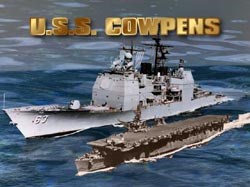
By the dim light of dawn on January 17, 1781, the Americans under Brigadier General Daniel Morgan, and the British under Lieutenant Colonel Banastre Tarleton, met and fought a battle that many historians consider to be the turning point of the American Revolution in the Southern Campaign. The site of the battle was a well-known pasturing area called the Cow Pens. In a little less than an hour, the Americans had won. This victory gave them the moral support that they needed to continue fighting the British and win at Yorktown, the last major battle of the American Revolution, just nine months later.
Two ships have commemorated the battle with the name USS Cowpens. CVL-25 The first was a light aircraft carrier of the Independence class in World War II. When her keel was laid on November 17, 1941, she was to be the light cruiser, Huntington, CL-107. However, the Navy needed more carriers than cruisers. In the meantime, George Dean Martin, owner of a drugstore in Cowpens, South Carolina, had written to President Franklin D. Roosevelt suggesting that an aircraft carrier be named for the nearby famous Revolutionary War battle, Cowpens. In those days, carriers were named for battles, so the ship was reclassified CVL-25, and named USS Cowpens. Her crew affectionately called her the "Mighty Moo."On October 5 and 6, 1943, she won her first Battle Star for the strike on Wake Island. She went on to earn eleven more Battle Stars and one Navy Unit Commendation before the war was over. On December 18, 1944, a typhoon struck the Cowpens and one crewmember was lost. Bombs and airplanes broke loose and careened about the deck. Crewmembers struggled against 100 mph winds and the rolling and pitching of the ship as they tried to secure the loose gear. The crew’s skill prevented major damage to the ship. The Cowpens arrived at Ulithi for repairs on December 21, and by the 30th she was at sea again for the Lingayen Gulf landings. The Cowpens also participated in the final raids on the Japanese mainland, launching photographic reconnaissance missions to patrol airfields and to locate and supply prisoner-of-war camps in August 1945. In addition, Cowpens was the first light aircraft carrier in the Tokyo Bay (8-27-45). From their ship, the Cowpens crewmembers watched the signing of the peace treaty on the USS Missouri. During the 22 ½ months that the USS Cowpens served in the war in the South Pacific, she flew 10,634 flights, participated in 2,452 action sorties, destroyed 108 enemy planes in the air, destroyed 198 enemy planes on the ground, dropped 657 tons of bombs, fired 3063 rockets, and sank 39 merchant ships. The USS Cowpens, CVL-25, was decommissioned January 13, 1947 and reclassified as an aircraft transport, AVT-1, but she never served in that role. She was sold for scrap in 1961. Click for more information on CVL-25. CG-63 On March 3, 1989, the US Navy launched the second USS Cowpens, CG-63, a guided missile cruiser from Bath Iron Works in Bath, Maine. She was commissioned two years later in Charleston, South Carolina, on March 9, 1991 and was the seventeenth Aegis cruiser of the Ticonderoga class. This ship is also known as the "Mighty Moo" and her crew call themselves "the Herd." CG-63 has state-of-the-art technology. Her Mark 41 Vertical Launching System, SPY-1B Phased Array Radar, and Phalanx Close In Weapon System (CIWS) enable the USS Cowpens to fight threats from the air. Her LAMPS Mark III SH-60B Helicopter combined with the AN/SQR-19 Tactical Towed Array Sonar (TACTAS) and AN/SQR-53B Hull Mounted Sonar make up the Anti-Submarine Combat System. She can fire Tomahawk Cruise Missiles, Harpoon Cruise Missiles, or her two 5 inch 54 Caliber Mark 45 Gun Weapon Systems against surface threats. Thus the USS Cowpens, CG-63 can fulfill her mission in all directions, up, down, and out. On January 17, 1993, while serving in the Persian Gulf, the USS Cowpens fired 10 Tomahawk missiles in response to Iraqi violations of sanctions that the United States had imposed. Ten years later, on March 20, 2003, she fired the first tomahawk missile into Iraq during Operation Iraqi Freedom.
The histories of the Battle of Cowpens and of CVL-25 are noted in CG-63’s coat of arms. Muskets, bayonets, and a drum represent the Revolutionary War battle. It is also depicted in the three lines that represent the three lines which Brigadier General Daniel Morgan placed his troops. In addition, the motto, "Victoria Liberatis Vindex", Latin for "Victory Vindicates Liberty" was on the medal which Congress awarded Morgan for his valor and leadership at the Battle of Cowpens. The colors blue, gold, red, and green represent the Navy Unit Commendation that CVL-25 earned, and the twelve stars in a circle represent the battle stars. In addition to symbolizing its history, the Coat of Arms denotes the capabilities of CG-63. The Navy sword signifies both the heritage of service and the vertical launch qualifications. The rays shooting upward represent the combat air support and the Aegis Weapons System of CG-63. The newest USS Cowpens expects to live up to her heritage and serve the United States of America to the best of her ability. For more information on CG-63, go to their official webpage. |
Last updated: April 14, 2015

